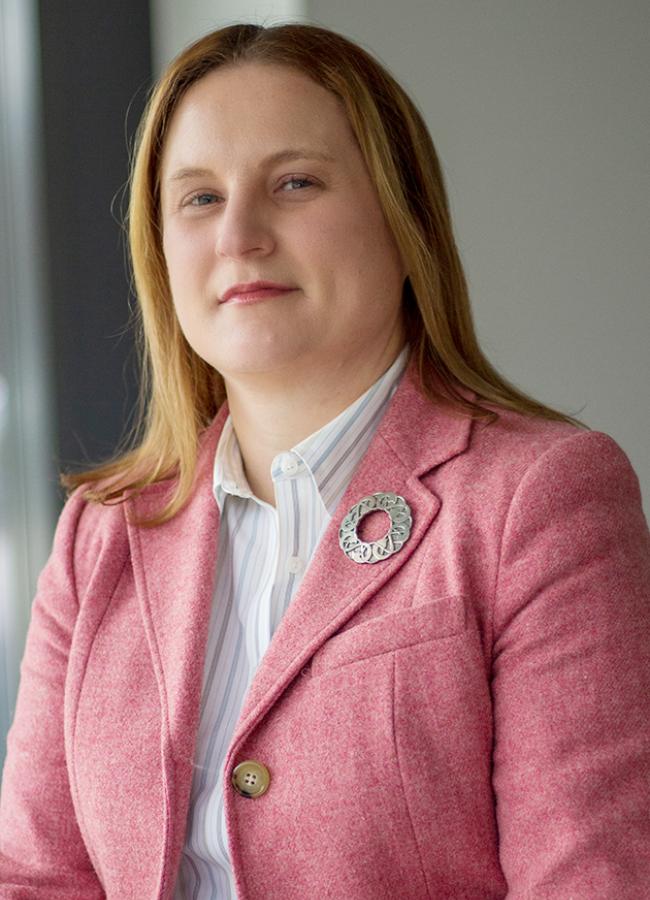Abigail Charest, Associate Professor, Civil Engineering

The David Blittersdorf Professorship provided the resources for me to create a new vision for undergraduate research and establish graduate research in the Civil Engineering Department. Additionally, this year the department had its first full-time graduate student. The materials for the Applied Research course and the department funding for a graduate student were made a reality through the professorship.
Teaching:
I was able to develop and teach a new course in Applied Research. There were seven students in the course. Prior to this year, students could volunteer to help with research projects. These students were motivated but this format did not allow for inclusive excellence. Some of our students need to work outside of class time and are unable to volunteer. As a part of the David Blittersdorf Professorship, I created a new course in Applied Research that allows any student interested in research to conduct research as a part of their coursework. I was also able to combine my teaching with internal and external campus activities. It is one of my personal priorities to connect students to professional practice. I find it imperative to teach students the importance of engagement outside of the classroom by demonstrating and discussing my own experience with service. In this regard, I worked with the United States Green Building Council (USGBC) to enhance student participation. Students attended USGBC events including a Net Zero seminar and Building Tech. Additionally, two Civil Engineering students—Sabrina Haarstick and Abby Morin—and I attended the USGBC GreenBuild International Conference and Expo in Atlanta, Georgia.
Research:
Over the past year, I facilitated two research groups. These groups have provided new opportunities for undergraduate research. My research includes themes of Sustainable Building and Water Quality. Over the past year, I have worked with several students to provide them with new opportunities.
Sustainable Building Research
This past spring semester I started a research project with the intent of measuring and analyzing sustainable mortar for historic preservation with the use of recycled fibers. The students conducted a literature review of reliable articles, which contained research methods and conclusions regarding sustainable concrete mixes, historical preservation methods, and analyses to measure CO2 quantities. Relevant articles that related to sustainability included alternates to partially or fully replace cement, production and benefits of using recycled plastic fibers, and reduced fossil fuel processes when making cement. Relevant historical preservation articles included the importance of preservation and characteristics to consider when choosing a repair mortar.
While many articles had discussed sustainability, very few were able to quantify sustainability. I began looking into how CO2 emissions were quantified in relation to production and use of mortar and found that the majority of methods used survey data from production plants and assessments of the life cycle of the products. However, almost no articles I found used laboratory experiments to quantify CO2 emissions. The undergraduate students completed a literature review paper, which was submitted to the Wentworth Undergraduate Research Journal.
One article I reviewed used thermogravimetric analysis and noticed at between 550 and 750 deg C calcium carbonate began to decompose and produce CO2. Using this logic the researchers were able to to compare the weight of the raw materials versus the finished mortar to quantify the CO2 being emitted. With this analysis in mind I began to develop laboratory experiments and mix designs, which would be used in an attempt to create a sustainable mortar with the use of 100% plastic fibers and lime as a cement replacement. Lime was chosen due to its extensive use in historical construction. Production releases less CO2 emissions, and lime-based mortars are quite durable thus requiring less maintenance or replacement and lasting longer making it a more sustainable option. Potential laboratory tests include compressive and tensile strength tests. Ideally a thermogravimetric analysis would also be utilized to measure CO2 emissions, and sulfate and acid resistance tests would also potentially be included to further analyze the durability of the mortar samples.
Water Quality Research
This research was used to investigates the occurrence and physical characteristics of viruses, which may impact treatment and survival in drinking water treatment. The outcomes of this research expand the current methodologies of nanoscale research by providing a time specific analysis of particle behavior. Determining the dynamic behavior of individual nanoparticles expands the current knowledge of viral transport in treatment processes, which is mainly based on size exclusion.
Previous literature in the field shows that while monitoring bacterial indicators within a water supply provides quality information about the source, viral indicators are better suited to model the fate of viral pathogens. Bacterial indicators, such as coliforms are not considered to be suitable for adequately indicating viral presence. With the relationship between coliphages and viral pathogens recognized, ultrafiltration can be used as a reliable water treatment system in the removal of any enteric viruses. This allows for the production of high-quality potable water through affordable and accessible means.
